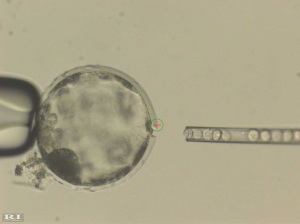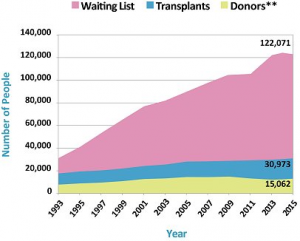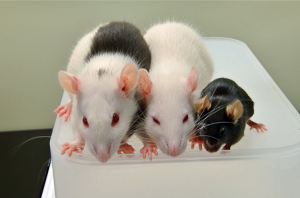BY BAR YOSEF| SQ ONLINE WRITER | SQ ONLINE (2016-17)
____________________________________________________________________________
In the January 26, 2017 issue of Cell, Salk Institute scientists reported on their breakthroughs in interspecies chimeras. Chimeras are organisms with organs of different species. The paper, whose first author is staff scientist Dr. Jun Wu, featured explanations of the scientists’ success in growing a rat pancreas, heart, and eyes in a mouse embryo. Their major development, however, was that for the first time ever, the scientists grew human cells and tissues in the embryo of a different organism. Specifically, they grew a human liver in a pig embryo. While Dr. Wu set out with the goal of creating organs for human transplant, he ended up getting involved in a deep ethical debate and pioneering an entirely new field of biology in interspecies chimeras.
BY: Can you introduce yourself? Where did you grow up and study and what brought you to the Salk Institute and to Dr. Izpisua Belmonte’s lab?
JW: My name is Jun Wu. I am a staff scientist here at the Salk Institute. I was born in China originally and I came to the states and did my PhD training in cell biology. Then I started working on […] human embryonic and induced pluripotent stem (IPS) cells for my first postdoc training at USC. Then, I came to Salk and continued this line of research.

BY: Can you explain the results of your study in layman’s terms?
JW: The ability of stem cells [is] to generate all cell types and tissues and organs in our bodies. Since it was discovered, especially human embryonic stem cells in 1998, there has been a lot of study worldwide to turn these cells into tissues and organs that we may need for transplant. The problem is that stem cell biologists don’t know exactly how to turn the cells into organs and tissues, especially three dimensional tissues and organs, in a plastic culture dish.

[…] But we know that in nature, every day in an animal and a human, a developing embryo [creates organs] all of the time and it is an incredibly efficient and fast process. For example, in a mouse, from one single cell to an entire organism, it takes only about nineteen days. The cells in a developing embryo know exactly where to go and what to become during this process. So, we were thinking, why not, since we don’t know all the instructions and factors that are involved in organ and tissue development, why not let the developing animal embryo guide the human cell so that the human cells can receive the proper instructions to turn into tissues and organs?

So that started the idea of using chimeras, using developing pig embryos so that human stem cells can generate a pancreas […] a heart [or] liver, so that hopefully in the future we can use these organs for transplant. And the reason we want to do it is because there is a worldwide shortage of organ donors, especially in the United States. There are more than 100,000 people waiting on a waiting list for an organ to become available. But this is not getting any better. The gap is increasing every year. There are the same number of donors every year, but the demand is increasing. To fill the gap, I think a strategy like this or alternative strategies to solve the organ shortage is needed and that is one of the major motives to do this type of research, as well.
BY: The methods used in this study, like stem cells and CRISPR-CAS9, which have both revolutionized the field of biology, as well as chimeras, have sparked a global ethical debate. For example, the “National Institutes of Health in 2015 instituted a moratorium on using public funds to insert human cells into animal embryos” (NYT). You were able to do this because you receive private funding. However, there is a lot of controversy surrounding your research. What are your thoughts regarding these ethical debates?
JW: We take all of these concerns very seriously. Before we can do a first experiment, we have to seek approval from several different ethical committees here in California and also in Spain. Because this is a fairly new direction of research, there are a lot of unknown phenomena. That is the reason it generates excitement and at the same time, generates fear, because people don’t know what to expect.
I think the major concern to me is that people worry that these human cells can go the brain, for example. […] And also the fear is that the human cells can go to the germ and become germ cells in the living species. So we will end up with a live chimera with human cells in the brain and the germ and that scares people.
What I can assure you is that this is not going to go in that direction. First of all, there are many barriers even to generate an interspecies chimera. Not only ethically, but there is a huge technical […] challenge. There is a reason that we are different species. For example, a human and a pig evolved distantly from each other about 95 million years ago and many of the factors for organ generation may not be the same. […] If the human cells are in the pig embryo, certain organs, such as the brain, may not receive the right signal to become perfectly functional human brain cells inside the pig. So that is one thing. The other thing is I think the gestation period between the human and pig are quite different. I think the pig [gestation period] is about […]112-114 days, but the human [gestation period] is about 280 days. So, the developmental speed is very different.
___________________________________________________________________________________________
“Because this is a fairly new direction of research, there are a lot of unknown phenomena. That is the reason it generates excitement and at the same time, generates fear, because people don’t know what to expect.”
___________________________________________________________________________________________
Also, as a scientist, I think we want to do everything we can to prevent those things from happening. For example, in this study we stopped the development of the pig at very early stages between 3-4 weeks old which is roughly corresponding to one circuit of the whole gestation. During this period of time, for sure [if there] is contribution of the human cell into the brain, the embryo is not conscious about it. As we know, the intelligence of human brain activity is trained through education, but at that embryonic stage, it is just a cell in the brain over there. But, starting [now], I think we can understand, gather more information.
The first question is whether human cells go to the brain or the germ at this stage, [and] how much they go. If they go there, how many cells are there, and what kinds of cells do they become? Also, we can look at this stage and say what organs the chimeras can potentially generate. Maybe there are some organs that are different between a human and pig, barriers there that we cannot cross scientifically. So, I think to gather more information at this stage is important so that it can help to give the public a more practical and realistic view of what this approach is about.
Also, by gathering more information we can develop strategies to keep human cells from going to the brain and the germ. […] Of course, the fear is still there. But, I think it is important to let the public and also other scientists know that we need to take a step by step approach and only by doing that we can […] implement the right strategy, a safe and sound strategy to move forward rather than go without thinking about all these concerns. I think it is important these concerns need to be considered by us and need to be considered by people who want to do this experiment.
BY: Is the reason you stopped at 3-4 weeks more for ethical reasons or scientific reasons?
JW: Both. This is the very first time we did this experiment. We don’t know what to expect. Although some people may believe that this is not going to happen, […] as a scientist we want to be very careful moving forward both for ethical and scientific reasons. Maybe there is no human cells. The paper answers the question, whether yes or no, whether human cells can contribute to chimera formation or not. For that, the answer is yes. […] The right thing is to stop it early and see how many cells contributed, which tissues contributed, things like that.
____________________________________________________________________________________________
“The paper answers the question, whether yes or no, whether human cells can contribute to chimera formation or not. For that, the answer is yes.”
____________________________________________________________________________________________
BY: Going back a few areas, clue us into your process. Like you said, it is a very uncharted area. How did you come up with the idea for this experiment?
JW: I was trained as a stem cell biologist, human stem cells. So originally [my goal was] to generate the organs that can be used for transplantation to solve shortages of organ donors. But I realized that it is a lot more than that. It’s not only that I generate the organs, but there is chimera formation. Interspecies chimeras [..] caught my attention later on, especially between the rat and mouse.
Later on, I realized this is an area that is really unknown. There are only a few studies. Before it was impossible to do or difficult to do because we didn’t have the right stem cells but right now, there is more understanding of the stem cells […]. I think that opens a door to this type of research, interspecies chimeras. So we put organ generation aside. We didn’t talk about humans; we talked about different species, the animals.
I think then it got exciting because this is actually a tool. You put two different species that are evolved separately into the same body and it is to me a live model of evolution. You have evolution in nineteen days in the rat and mice case. You have the rat cells that maybe evolved fifteen to twenty million years ago away from the mouse and now you put them into the same places and that can reveal many of the secrets that we didn’t know before.

For example, the rat doesn’t have a gallbladder for reasons we don’t really know, but they probably don’t need concentrated bile to support their everyday lives. But the mouse has one. If they evolved from the same species before that means the rat at a certain time during evolution in the past had a gallbladder, but they lost it. Whether the rat cells lost the ability to generate a gall bladder or the rat development suppressed the rat cells from generating gallbladders is unknown. But when we put the rat stem cells in the mouse, surprisingly we found the rat cells can actually generate a gallbladder inside a mouse. So that tells me that it is not that the rat cell’s ability [to generate a gallbladder] has been changed, but it’s just […] the environment.The mouse gallbladder can give the instructions to the rat cells so the rat cells can have instructions and become a gallbladder. In the rat, the instruction is not there anymore because in evolution or during evolution, this process has been suppressed.
So those types of things, I think, are fascinating. As a biologist, developmental biologist and stem cell biologist, this can basically unlock many of the secrets that if we look at them [the species] independently, we wouldn’t know. If we look at them together, then we will know which process is conserved, which organ is conserved, and why it’s more conserved. Maybe due to their habitat change or to the weather, the environment. So these types of things I think can open up, to me, a new field of biology to understand evolution and to understand species’ differences.
BY: What are your career goals moving forward?
JW: Like I said, I was trained as a stem cell biologist, but now through this, I learned a lot about evolution, about species, about development in different contexts. So, I think I will keep doing this. I will be very happy to be among the first few people that enter this field and to understand interspecies chimerism and to understand some of the secrets that we normally wouldn’t know. So that is my goal, to follow up with what I am doing.
____________________________________________________________________________________________
“So these types of things I think can open up, to me, a new field of biology to understand evolution and to understand species’ differences.”
____________________________________________________________________________________________
Another aspect, which I really, really want to go into in addition to the organ generation is whether we can use the same strategy to preserve endangered species. For example, whether we could generate stem cells from the skin of endangered rodents and use a rat and mouse as an incubator to generate the cells of gametes to preserve the species forever. So that is another goal I want to look into, but we don’t know at this stage, whether this is possible.
BY: A large portion of our readership is undergraduate students in the biology department. What advice can you give to budding researchers?
JW: One suggestion I will give is that as a young researcher, I think open your mind. At the same time, be aware of the moral values and ethics. I think that is something that scientists in the new generation should [be is an] open minded scientist who is open to many different directions and possibilities with the intention to improve human health, to help the human race. […] I think as an individual scientist it is important to be aware of that and to know the boundaries, but don’t let the boundaries limit your imagination. […] I think that our experiment, when we first thought about it, was unknown, totally uncharted area. When you go to areas that have zero information, of course, the reaction will be fear and excitement at the same time. […] We need to find the right dose of those two.
[hr gap=”0″]
Sources:
- www.salk.edu/news-release/new-findings-highlight-promise-chimeric-organisms-science-medicine/
- www.theguardian.com/science/2017/jan/26/first-human-pig-chimera-created-in-milestone-study
- www.washingtonpost.com/news/speaking-of-science/wp/2017/01/26/scientists-create-a-part-human-part-pig-embryo-raising-the-possibility-of-interspecies-organ-transplants/?utm_term=.8c8b84ea7c83
- www.nytimes.com/2017/01/26/science/chimera-stemcells-organs.html

